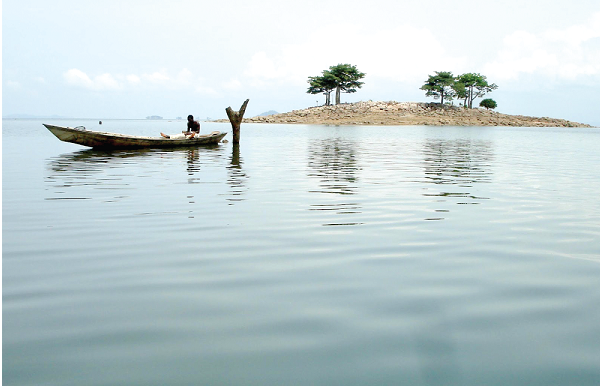
Harnessing the unused potential of Lake Volta
Roughly 60 years ago, the government of Ghana under the leadership of President Kwame Nkrumah decided that Ghana needed electricity for industrialisation to drive development.
A massive hydroelectric dam was to be the source of this major national enterprise. The dam site at Akosombo was chosen and the rest is history.
Advertisement
To create the lake from which electricity would be generated, over 100 villages were destroyed and over 80,000 people and their livestock had to be relocated to newly built towns and villages.
Ideally, the valuable trees in the forests in the area to be affected should have been removed before it was flooded with billions of cubic metres of water, but Ghana was in a hurry and in any case supplies of quality hardwood seemed inexhaustible. Apart from that, there were more pressing problems such as raising £130 million pounds ($4bn in today’s money) to pay for the dam and relocate the remote communities.
Largest man-made lake
Lake Volta is the largest man-made lake in the world by surface area, spanning the Volta, Eastern, Brong Ahafo and Northern regions, and covering about four per cent of Ghana’s surface — 8,502 square kilometres. It is Ghana’s largest single geographic feature and extends 400 kilometres from the north to the south.
The estimated 14 million cubic metres of recoverable quality hardwood, submerged and preserved by the waters of Lake Volta, is now Ghana’s remaining living forest. The timber industry in any case is more or less dead due to exhausted forest stock. Timber salvaged from Lake Volta can revive Ghana’s timber industry in an environmentally friendly way, regaining timber export revenues while allowing the regeneration of our precious forests.
Salvage commercial timber
Kete Krachi Timber Resources (KKTR), based at Sedom-Yiti in the Eastern Region, is the Ghanaian company with the concession to salvage commercial timber from Lake Volta, using sophisticated sonar equipment to locate submerged trees, as well as unique mobile salvage barges that can cut and raise a tree to the surface in five minutes.
Lake Volta contains hundreds of millions of trees, the tops of many of which are today visible because of the drop in the lake level. They are a deadly hazard to travel and navigation on the lake. It is worth remembering that the only means by which people in the many surrounding communities go from point A to B is by boat. Under such circumstances, safely travelling around the various communities is all but impossible.
Too many accidents have occurred on the Volta Lake as a result of boats colliding with the trees and capsizing. There is a critical need to improve safety by clearing the navigation channels of trees and marking out the channels created. The KKTR has the requisite equipment and expertise to perform this clearance, and has already successfully cleared the Dambai–Dodoikope channel under the auspices of the Ghana Maritime Authority, the government agency tasked with maintaining safety on all of Ghana’s water bodies.
Removing tree stumps
Removing the tree stumps along navigation lanes in the lake will revitalise farming communities along the northern shores of the lake by reducing post-harvest losses and improving access to markets for these communities which are among the most impoverished in Ghana.
In addition, removing tree stumps will aid in the lake achieving its massive potential for tourism and aquaculture. With respect to tourism, the stumps prevent the use of the lake for water sports, and are a hazard for seaplane landings that could make the furthermost points of the lake accessible from Accra in under two hours.
Aquaculture
For aquaculture, the potential is immense. Ghana imports 600,000 tonnes annually of frozen fish, all of which can be produced by inland aquaculture, with the majority coming from Lake Volta. Tropo Farms, sub-Saharan Africa’s largest aquaculture operation, is a leader in this industry.
Aquaculture in Ghana presently produces 30,000 tonnes per annum of mainly tilapia, and with the clearance of stumps from selected areas, volumes can expand dramatically over the next few years. This will bring relief to fishing communities on Lake Volta who are experiencing steadily declining fish catches due to diminishing fish stocks.
The decline in fish stocks is a result of unsustainable fishing practices, the most prevalent of which is the illegal practice known as “bamboo fishing”. This banned practice entails using lines of baited stems of bamboo which are then attached to tree stumps and submerged, to be periodically raised and emptied.
The reason this fishing practice is illegal is that pregnant fishes are especially attracted by the dark spaces in the bamboo trap, so a disproportionate amount of them are caught, drastically reducing the numbers of the next generation. In addition, lost bamboos fall to the bottom of the lake where they continue to trap and kill fishes. Ghana’s Ministry of Fisheries is making renewed efforts to educate communities on the effects of bamboo fishing and enforce the ban, but it appears the effect of this practice will continue to be felt for several more years.
A growing aquaculture industry is surely the way of the future and lakeside communities in search of a better standard of living are excited about the prospects. Tropo Farms and KKTR, the two leading private commercial enterprises on Lake Volta, are just as excited. They are embarking upon a joint corporate social responsibility (CSR) programme to assist fishing communities profitably engage in large-scale aquaculture. Things could look a whole lot different several years down the line.
The writer is the
Chief Executive of Channel Two.
Cell: 024 4310305
Email: [email protected]




